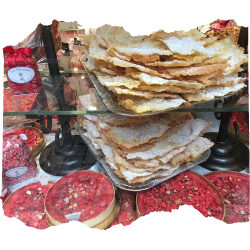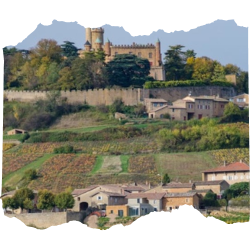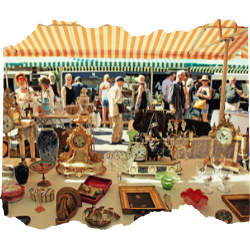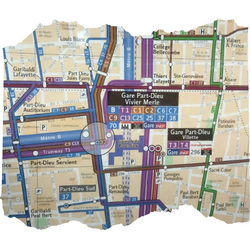Unsure about your French table manners? Click Here to download > > How to avoid these 10 food etiquette mistakes !
- Home ›
- Destinations ›
- Lyon ›
- La Croix-Rousse
ode To Croix-Rousse, Lyon's Bohemian Silk Weaving Hill
Published 18 December 2020 by Leyla Alyanak — Parisian by birth, Lyonnaise by adoption, historian by passion
The first time I visited Croix-Rousse, I walked up. I'm now convinced that taking Metro line C to the top and walking back down is far more rewarding!
Looking up the hill of Croix-Rousse, you might curse not having worn better gripping shoes as you slide across across a cobblestone step or wonder just how much higher you'll have to go.
Central Lyon is flat, but I’ve been climbing for what seems hours.
I look up the Montée de la Grande Côte, once a country lane bordered by vineyards. It later became a proper street along which Lyon’s canuts, or silk workers, scurried from their hilltop workshops to do business with merchants and traders below.
Today, the street is partly pedestrian, starting out narrow and broadening, lined with shops and eateries and side streets that twist and darken into the distance.
Croix-Rousse, the "hill that works", is one of two hills in Lyon, the other being Fourvière Hill, the "hill that prays".
NOTE: Pages on this site may contain affiliate links, which support this site. See full Privacy Policy here.
Croix-Rousse: Piercing through Lyon's silk district
Behind me is an extravagance of sceneries, flower pots at eye level and a cascade of buildings unfurling towards the Saône below, their ochre roof tiles warmed by the afternoon sun, like stone steps on a hot summer day, opening up to one of the prettiest cities in France.
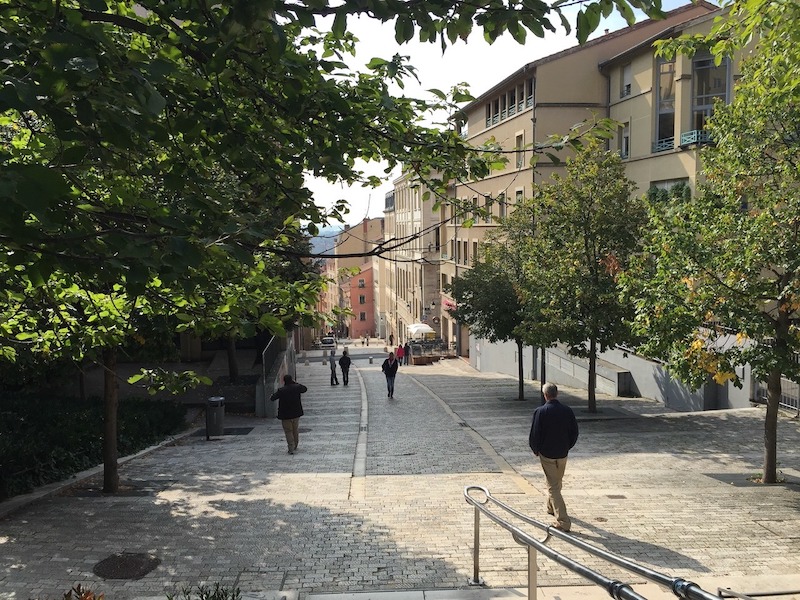 Looking down towards Lyon from halfway up the Croix-Rousse
Looking down towards Lyon from halfway up the Croix-Rousse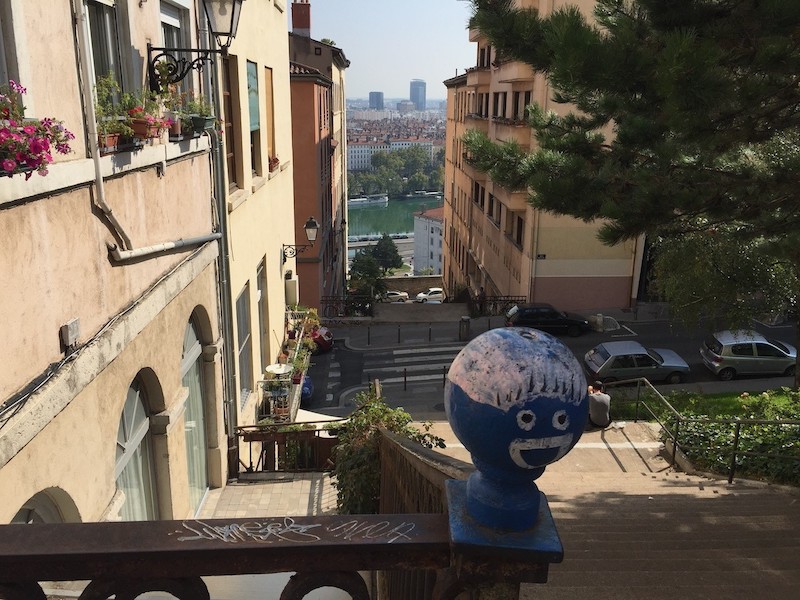
If you continue the climb, you'll cross students and shoppers skipping lightly down the steps, eyeing you against the flow, with curiosity. If I concentrate I can imagine hearing operatic divas practice their scales, shrill voices echoing off the buildings on either side of the street.
Heading up, the cobblestones give way to a park whose modern steps are separated by a railing. No shame in using it to propel yourself forward.
I cheat and sit on a bench I share with an Argentinian couple too preoccupied about a missed train to admire the scenery below.
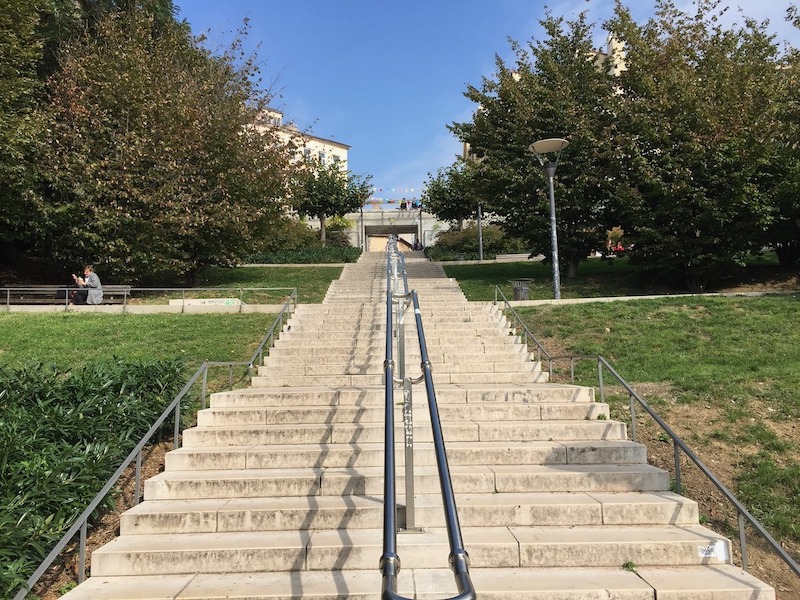
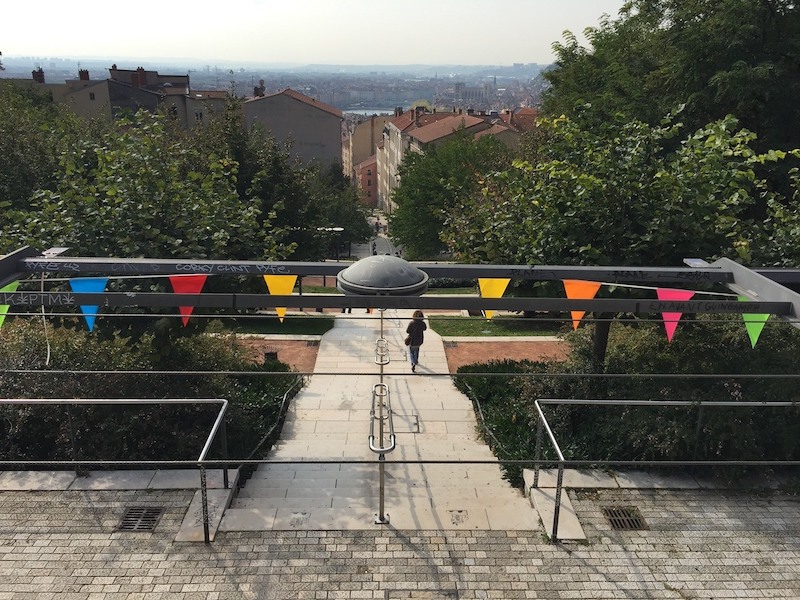
Lyon: A tale of many cities
Lyon has always reminded me of an onion, shedding layers as one cuts deeper or looks more attentively. More than a city, it is an agglomeration of neighbourhoods that history has stuck together, whether they wanted it or not.
There are so many unusual and interesting things to do in Lyon...
I began my uphill trek at the Place des Terreaux, a complex square in the city proper that houses Lyon’s historic mid-17th century City Hall and the Opera House.
As I began to climb, cars disappeared and people started wandering into the center of the street, knowing they would be safe.
I had entered the hill of Croix-Rousse, a once-independent village so proud that today, more than 150 years after it joined Lyon, its residents still call themselves Croix-Roussiens, not Lyonnais.
Nearing the top, a small sunlit square has been taken over by students sunning themselves on the café terrace of the Montana (an unlikely name for a Moroccan Berber restaurant) or swinging their legs over the void at the edge of the wall above the park.
The Grande Côte becomes the Rue des Pierres Plantées, and so it stays until it reaches a vast plateau where it opens onto, of all things, a cheerful carousel and country-ish fair.
But it is lunchtime and I’m not one to delay that daily event so I settle down for a delightful andouillette (chitterlings and pork, with onion, wine, cream and mustard in the sauce...) and gratin dauphinois at the Café du Gros Caillou, or Great Rock, named so for a great rock that sits right out front like a crown upon Croix-Rousse.
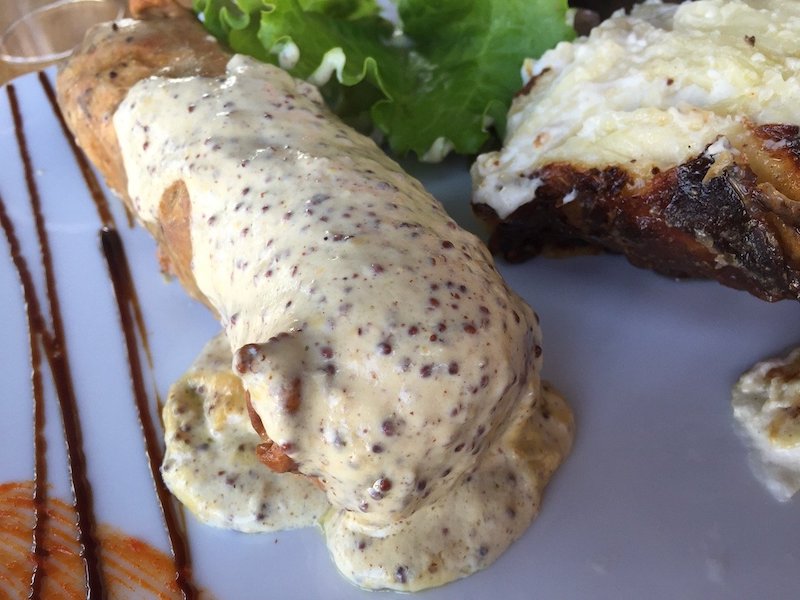 More to the point is what in inside, on the plate: a classic Andouillette with mustard cream sauce and a Gratin Dauphinois, not light, but exquisite
More to the point is what in inside, on the plate: a classic Andouillette with mustard cream sauce and a Gratin Dauphinois, not light, but exquisiteFrom the top of Croix-Rousse, the city looks a lot farther than the distance I thought I’d walked.
Croix-Rousse, a UNESCO World Heritage site, is to a certain extent organized to help the walker, and small signs on buildings help direct you towards the main sights (not always, though!).
After wandering around for a bit, you may feel it's time to start the journey back down. You can return the same way, but I wouldn't. Instead, I'd work my way slowly down the hill, winding through the streets and, when necessary, using the stairways that appear at intervals in case the cobblestones are too treacherous. This is the best way to discover the silk-weaving soul of Croix-Rousse.
You might also like these stories!
The silky heritage of Croix-Rousse
For centuries Croix-Rousse was the heart of Lyon’s silk trade, and Lyon the European capital of silk. Little silk is made here these days but you’d never know that from visiting the workshops and sites dedicated to the ancient art.
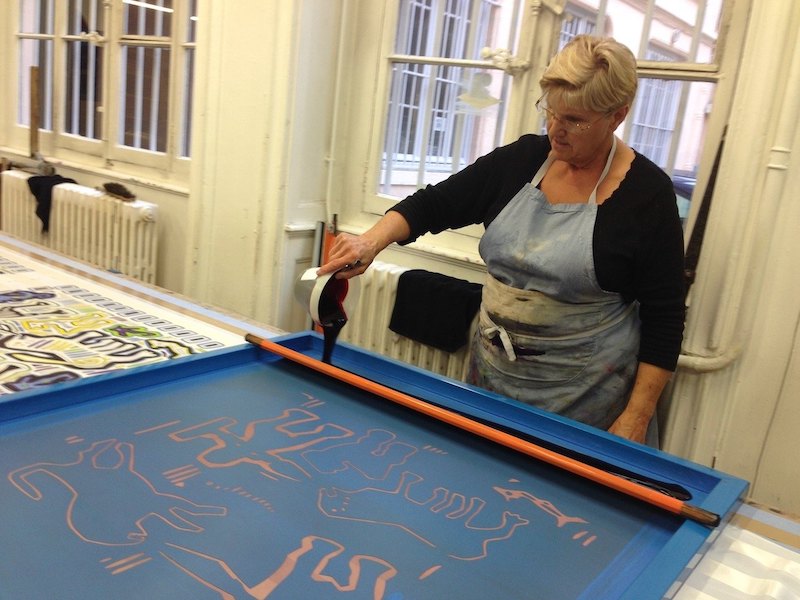 Silk-screener at work in Croix-Rousse, Lyon
Silk-screener at work in Croix-Rousse, LyonYou'll find silk everywhere.
It is in the names: on the plaques adorning buildings whose façades are pierced by many windows, allowing daylight into former silk workshops. It’s in the word canut – or silk worker – which appears everywhere from food (cervelle de canuts, a white herb and garlic cheese) to street names (Boulevard des Canuts) to museums (House of Silk or Maison de la Soie).
Silk is in the guignol, that most local of puppet shows born to entertain silk workers on Sundays.
Silk also pops up in restaurant lore.
Those famous Lyonnais eating establishments, the bouchons, were initially opened to feed silk workers a mid-morning snack – potatoes, herring or cod or anything pig-related, often left over from dinner the night before. The woman would be in the kitchen (of course) and the man would handle service and the wine cellar.
These eateries, in their heyday, were frequented by men of all classes: businessmen, silk industrialists, workshop supervisors and silk workers.
Today, we women are welcomed. And the fare has diversified to such Lyonnais staples as the salami-type rosette, fried pork rinds, various gratins (baked vegetables with a creamy béchamel sauce) or local cheeses. And wine. Much wine, given that this region is called Côte du Rhône.
I end my silk-informed afternoon at the Maison des Canuts, a former silk-weaving cooperative turned museum that traces silk’s history in Lyon and shows how it was made, original machinery intact.
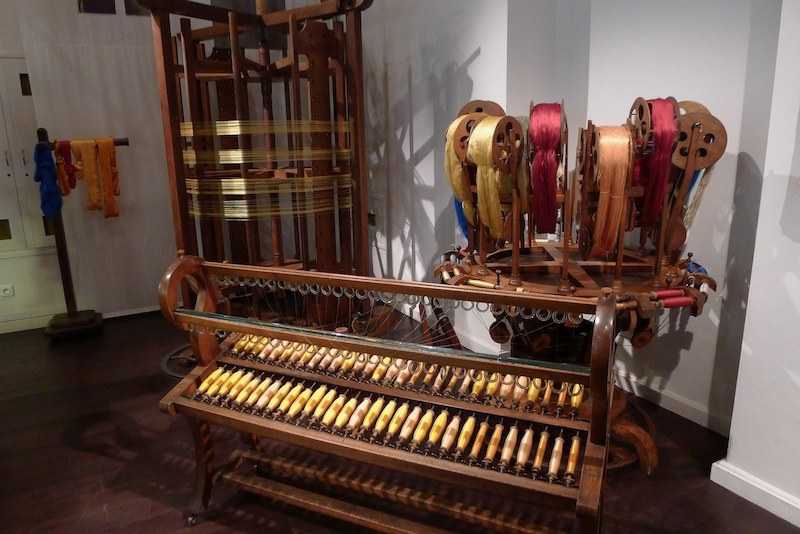
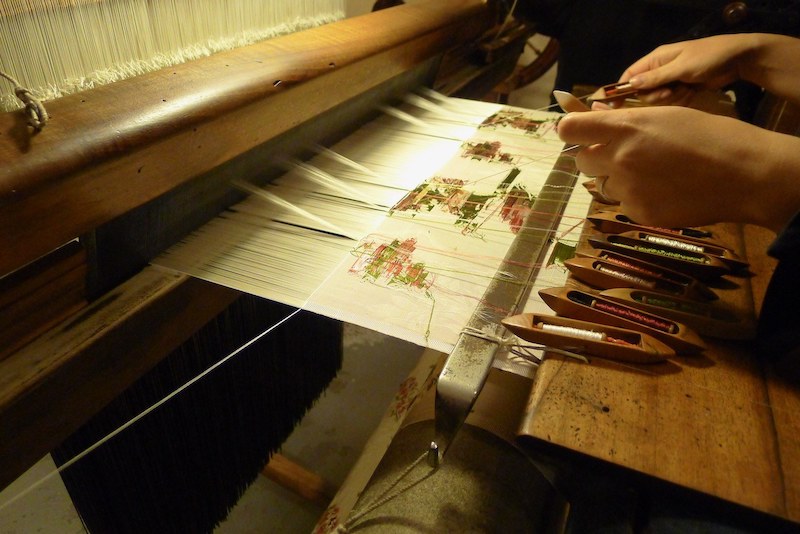
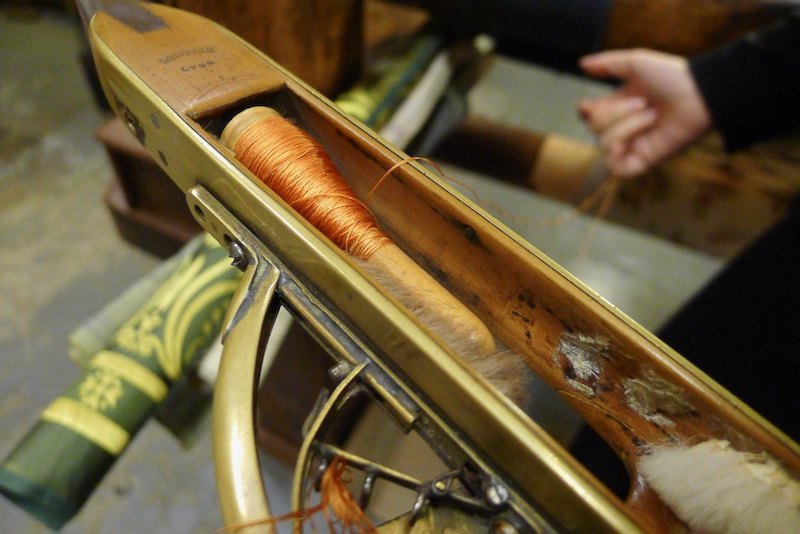 The Maison des Canuts provides a fascinating visit, not only about the history of silk in Croix-Rousse and Lyon more generally but on the weaving process; much machinery is still in working order and demonstrations will help you understand just how much was involved in preparing that precious scarf when everything was made by hand
The Maison des Canuts provides a fascinating visit, not only about the history of silk in Croix-Rousse and Lyon more generally but on the weaving process; much machinery is still in working order and demonstrations will help you understand just how much was involved in preparing that precious scarf when everything was made by handThere are plenty of silk shops on Croix-Rousse, by the way, in case you want to get up close and personal. Of course, I didn't walk out empty-handed… (Here are some Etsy shops with French silk scarves, if you'd like to buy yourself a present!)
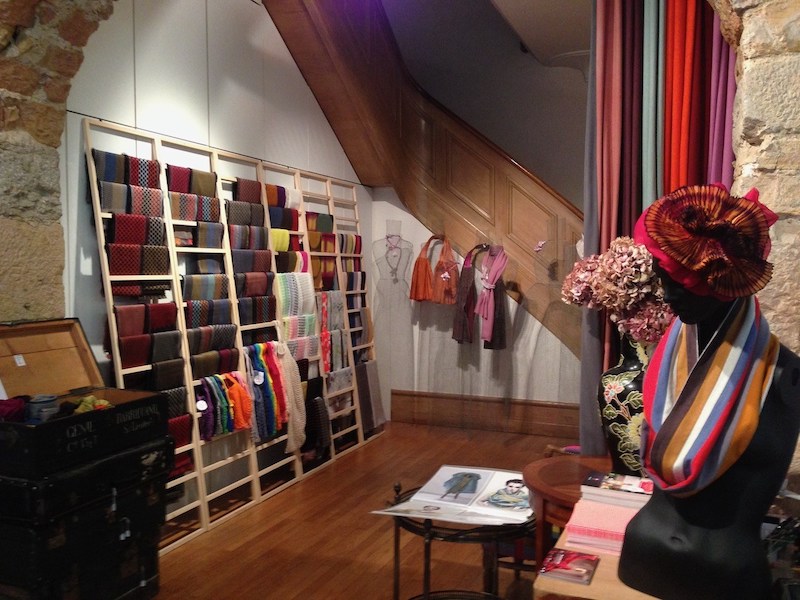 One of Lyon's many delightful silk shops
One of Lyon's many delightful silk shopsWandering the streets of Croix-Rousse
As I make my way back downwards, I search for one of the most famous traboules. Traboules are ingenious passageways that connect Croix-Rousse to Lyon below. Visitors find them intriguing but they originally kept bolts of silk from being spotted and splashed by heavy rains as they were carried from the workshops on the hill to the expensive shops along the riverbanks. (Traboules aren't the monopoly of Croix-Rousse: you'll find them all over town, and a few of the most visited are in the Old Town of Lyon.)
So I search for the well-known Cour des Voraces.
Not only is it one of the area’s longest passageways, but it played a role in the silk weavers’ revolution, launched to fight for better working conditions. The Voraces also has links to the French resistance during World War II, helping rebels escape the Nazis who then occupied Lyon.
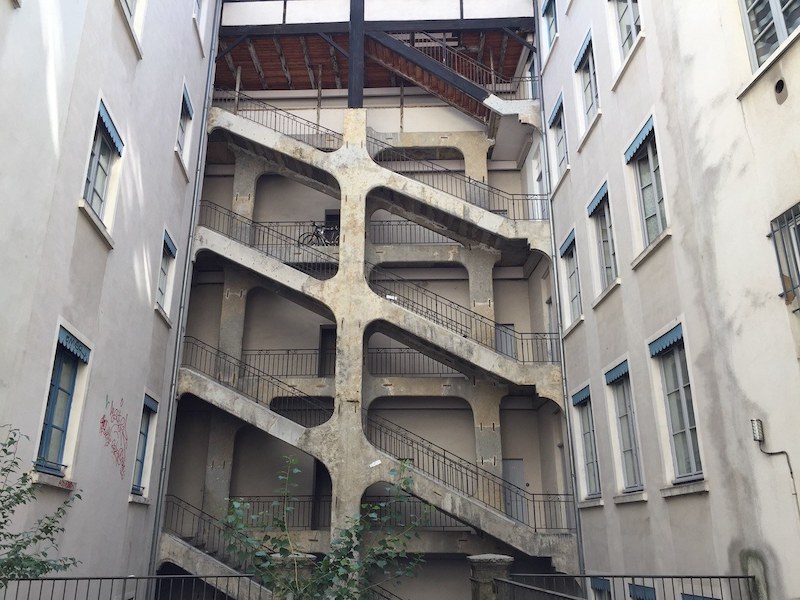 The Cour des Voraces, one of the city's most visited traboules - a passageway beneath the stairwell will take you through to the other side
The Cour des Voraces, one of the city's most visited traboules - a passageway beneath the stairwell will take you through to the other sideMost signs on the traboule map point to the Place Colbert but once here, the signs disappear, expecting you might magically intuit the traboule’s location.
As I look in vain for the entrance, I watch others search for the noted passageway. They hold maps, point at walls and try to avoid two inebriated men sprawled on a bench.
Eventually I spot two women walking with purpose and follow them into a dark hallway whose stairs leads into a courtyard, around a corner, down a dark passage and out into a narrow alley. I cross the street and enter another dark doorway.
I eventually find not only the Cour des Voraces, but many other traboules which will, one after the other, take me halfway down Croix-Rousse hill by luring me into one door and propelling me out of another.
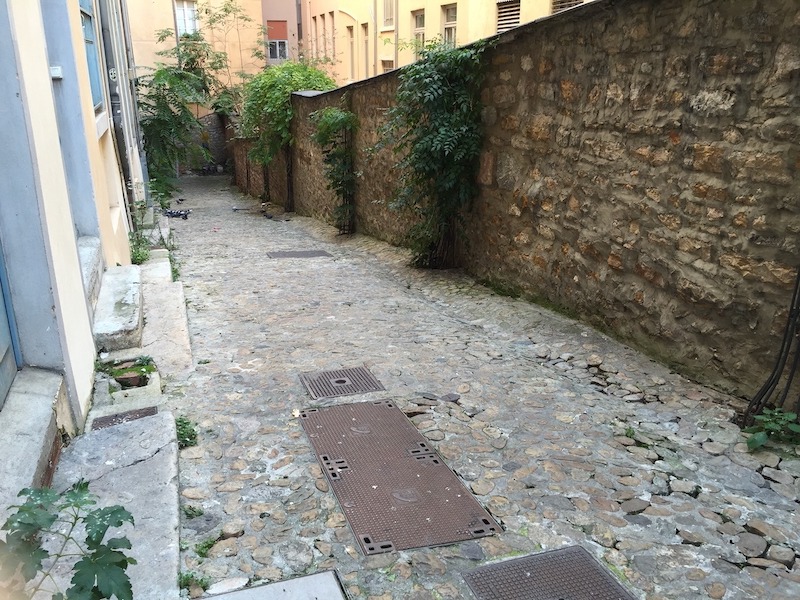
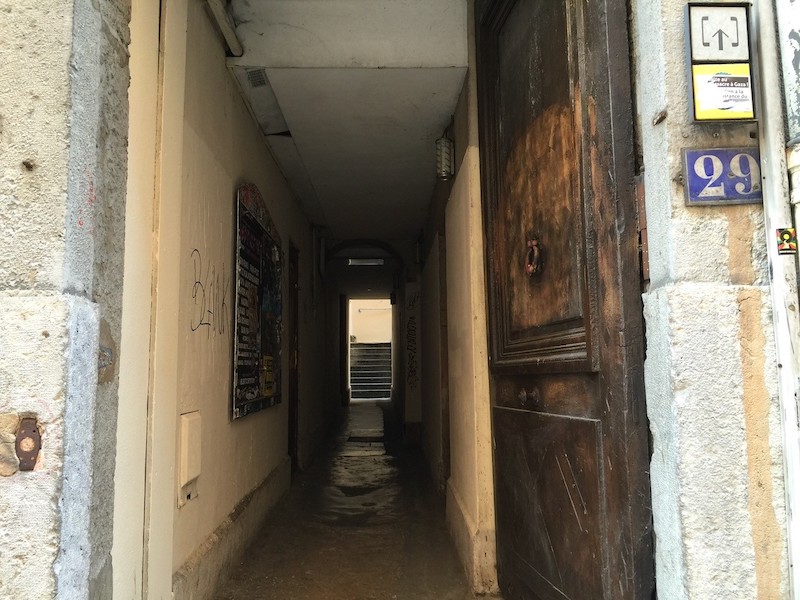 It’s easy to imagine a silk worker rushing madly from top to bottom with a heavy bolt of silk on his shoulder to avoid the rain
It’s easy to imagine a silk worker rushing madly from top to bottom with a heavy bolt of silk on his shoulder to avoid the rainAs I wander the streets looking for traboules, I discover an atmosphere that doesn’t feel like Lyon at all. (It isn’t Lyon, the Croix-Roussiens would say.)
The people aren’t beautifully dressed burghers or tourists. They are students staggering under the weight of their books, or they are old men calling park benches home, their belongings hooked into their elbows or fingers while they sleep. On this warm autumn day they are part of the scenery. Winter is a different story...
Signs on streets and shops are in French – and Spanish and Arabic and Turkish, a cauldron of cultures in which immigrants haven’t lost their roots. I stumble into an art gallery whose owner is explaining his art to a wealthy Swiss couple.
“That wave isn’t a wave. It is the evolution of feeling, of love, it is my vision of the Midi, where the land meets the water.”
The artwork is pasted onto brown wrapping paper which itself is mysteriously mounted on the wall. Should the Swiss decide to buy it I’m not clear how they’ll take it home.
There is art on street walls, too, graffiti designed to bring color to streets whose narrowness prevents sunlight from piercing through. And theater, tiny establishments which probably still smell of smoke many years after the ban, with squeaky wooden seats and youthful spectators in turtleneck sweaters, fresh from their aperitifs.
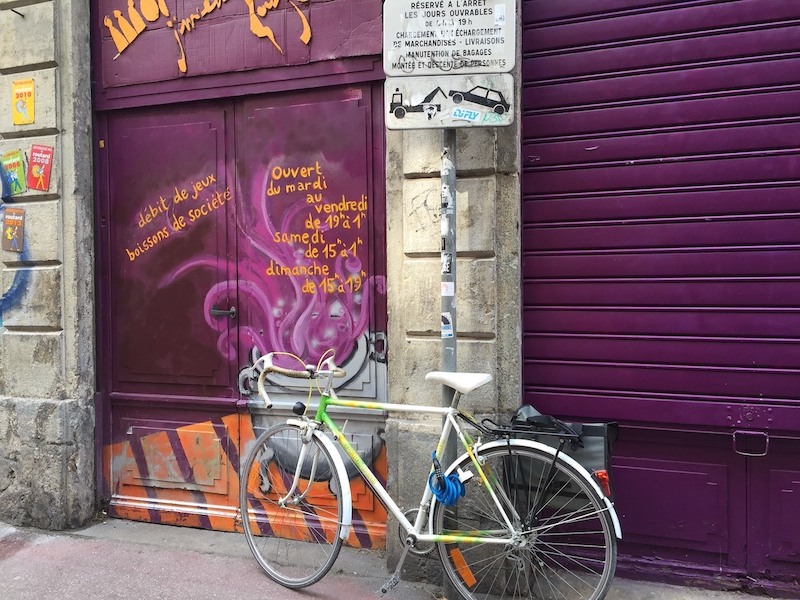
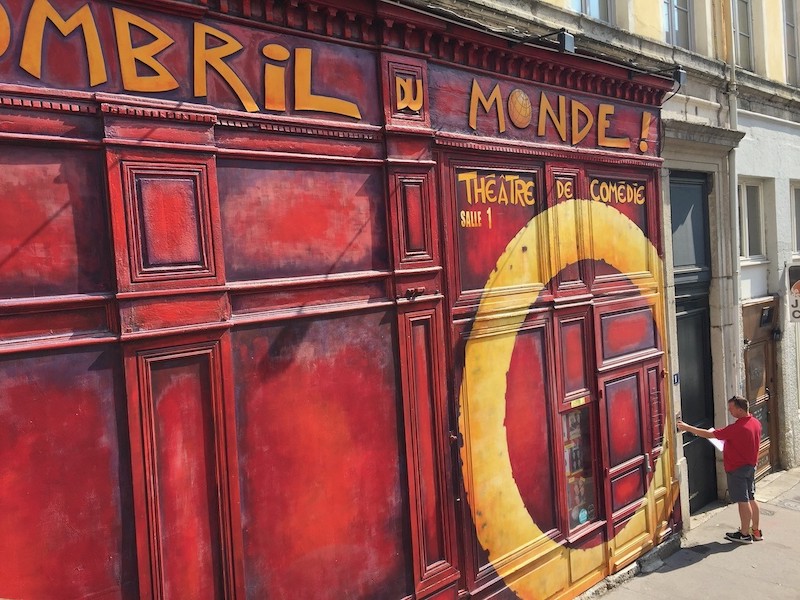
Croix-Rousse is part village, part festival, a bit of a rebel, an alternative Lyon away from the staid, upstanding plains below.
You can see the Croix-Rousse hill from almost anywhere in Lyon, a crowded incline that may remind you a bit of Montmartre in Paris, but without the street painters and with far fewer tourists. Whereas Montmartre has art at its heart, Croix-Rousse owns the world of silk.
You may be tempted to brush off silk as a quaint historical footnote but as I wander, I realize that Croix-Rousse has been shaped by silk, from the light that bounces off workshop windows on the upper hill to the homes of those who owned or worked in them a bit below.
And lest we forget, Croix-Rousse has painted its history in public, on a huge wall called the Mur des Canuts.
Look closely. Are you seeing a painted fresco or a slice of daily life? The wall depicts part of the silk history of the area but mixes it with present-day scenes in a near-mirage of reality over art. Lyon is famous for its murals but this particular one is so monumental you could gaze at it for an hour and still not see every intricacy.
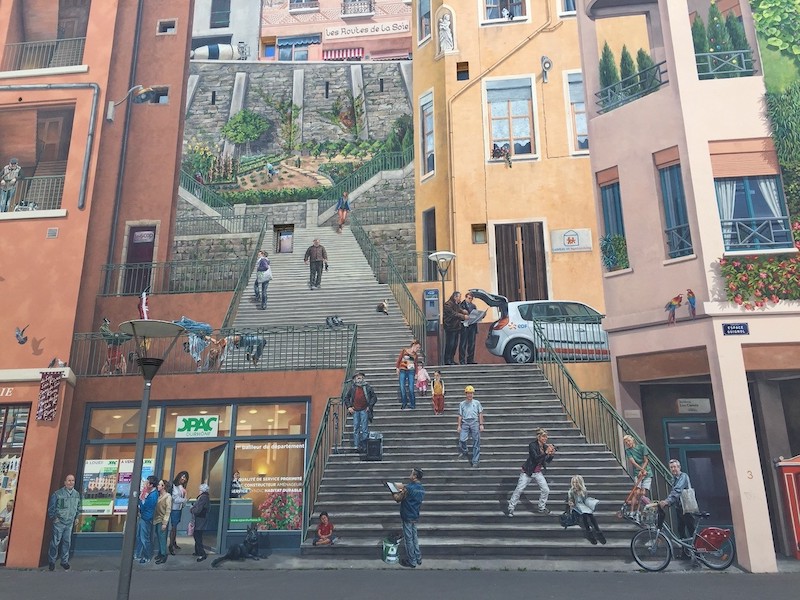 This is a small corner of the fabulous Mur des Canuts, one of Lyon's most spectacular murals
This is a small corner of the fabulous Mur des Canuts, one of Lyon's most spectacular muralsEven if you've been to Lyon before, you may never have ventured far from the core, beyond the refurbished and gentrified old town, the alleys crowded with restaurants, the shopping boulevards.
Yet understanding Lyon and its history will inevitably route you through Croix-Rousse.
They say Lyon was built on silk, but they must actually mean Croix-Rousse because this, after all, is Lyon's heart of silk.
Where to buy silk in Lyon
Plenty of shops offer locally made silk and here are just a few of the highly reputable ones:
- Brochier Soieries, right in the heart of the Old Town, the Vieux Lyon
- Soierie Saint-Georges, making silk the traditional way
- L'Atelier de Soierie, with a great online catalogue
- CathAm Soie, for modern creations
- Sophie Guyot, an irresistible shop
There are many more – these are simply designed to whet your appetite.
To find out more about silk in Lyon, visit the following:
- Maison des Canuts (tours are in French but the museum is universal)
- Lyon Silk Festival (Facebook page), held annually
- Soierie Vivante: tour a workshop and watch silk being made
Ready for your Lyon trip?
Here are some suggestions to make your visit even more enjoyable!
TOP LYON CITY TOURS
➽ Vieux Lyon 4-hour Food Tasting Tour - for inveterate foodies and gastronomes
➽ Discover Lyon Walking Tour - to explore the essence of the city
LYON DAY TRIPS
➽ Golden Stones Beaujolais - heart of the Golden Stone villages for wine lovers
➽ Northern Côtes du Rhône - meeting the winemakers
➽ Beaujolais and Pérouges - wine tasting and a medieval village visit
WHERE TO STAY IN LYON
➽ Villa Florentine - stunning 5-star luxury overlooking the entire city
➽ Mi-Hotel Tour Rose - perfect apartments in historic Vieux Lyon
➽ Fourvière Hotel - elegant simplicity in a former cloister
➽ Hotel du Théatre - budget option in the heart of the classical district
Renting a car in Lyon? Compare prices here.
Traveling here by train? Book your ticket here.
To see the city, don't forget to book your Lyon City Card.
